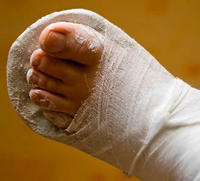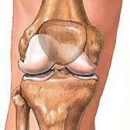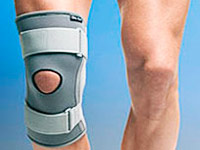What are the causes of aseptic necrosis? What are the syptoms of aseptic necrosis? How to diagnose this disease? Answers to these questions you will find in the article.
Content
Causes of aseptic necrosis
The development of aseptic necrosis of the femoral head can cause many factors. Almost any reason contributing to the violation of blood flow in the artery of the hip head can be a jolts for the development of aseptic necrosis. So injury damage to the hip joint can lead to a violation of the blood supply of the hip head as a result of the mechanical damage or thrombosis of the artery. The most frequent injuries leading to the development of aseptic necrosis are the fracture of the thigh and dislocation of the thigh. Aseptic necrosis develops in a few months, although the first clinical symptoms, as a rule, appear in patients much later (often in 1.5-2 years after the suffered injury).
Reception of some medicines can also contribute to the development of aseptic necrosis. Most often aseptic necrosis develops against the background of long-term admission of high doses of glucocorticoid hormones over heavy rheumatic diseases, bronchial asthma, etc. It is shown that treatment with short courses of hormonal drugs does not increase the risk of developing aseptic necrosis of the femoral head. It is also safely in this regard single or two-time intra-articular or otolossertive introduction of hormonal drugs in the treatment of osteoarthrosis, bursites, tendonites and other inflammatory diseases of the musculoskeletal system. The clear relationship between excessive alcohol intake and the rate of development of aseptic necrosis is traced. Alcohol contributes to damage to blood vessels, which can cause the development of ischemia of the head of the femur and the development of its necrosis. The increased frequency of the development of aseptic necrosis is noted in persons whose professional activities are related to the impact of high pressure (divers, miners). In case of improper mode of decompression in the blood, fine air bubbles are formed, which can block and damage blood vessels, including leading blood flow in the arteries of the femoral head.
Symptoms of aseptic necrosis
 The first symptom of aseptic necrosis is pain in the area of the hip joint, which occurs when transferring body weight to «Patient» foot. Pain may apply to inguinal, buttock areas, irradiate (give) on the front surface of the thigh. When progressing the disease, a chromoty and violation of the function (mobility) of the joint appears. In the later stages, pain can also be kept alone, promote sleep violation.
The first symptom of aseptic necrosis is pain in the area of the hip joint, which occurs when transferring body weight to «Patient» foot. Pain may apply to inguinal, buttock areas, irradiate (give) on the front surface of the thigh. When progressing the disease, a chromoty and violation of the function (mobility) of the joint appears. In the later stages, pain can also be kept alone, promote sleep violation.
Diagnosis - Aseptic necrosis
The diagnosis of aseptic necrosis begins with the study of patient complaints, disease history and physical research. The doctor will ask you about the presence of chronic diseases, medication reception, about professional bindings. Perhaps the question of alcohol abuse will be asked. Physical research includes inspection, palpation of the joint and the study of its function (an angle of the lead, flexion of the limb, etc.). To clarify and confirm the diagnosis, it is necessary to carry out additional laboratory and instrumental methods of the survey.
Radiography
On radiographs, the zone of aseptic necrosis of the head of the femur is determined, as a rule, with sufficient duration of the disease. In the early stages of the disease with a x-ray study of pathological changes, the bone may not be determined, despite the fact that the patient can already disturb pronounced pain in the joint. In the later stages of aseptic necrosis, osteoarthritis is joined, and it is difficult to determine which of these diseases causes a greater extent that the patient has symptoms.
Radioisotope scanning (scintigraphy)
In the absence of pathological changes in radiographs, the doctor may assign radioisotope scanning to clarify the diagnosis. With this technique, a drug is introduced into the patient's body containing a radioactive element (radiopharmaceutical). After a few hours, with the help of a special gamma chamber, radioactivity registration is carried out in the human body. Due to the absence of blood flow in the head of the femoral bone, this zone on a scintigram (a picture obtained by scintigraphy) is presented as «cold» stains, since it does not accumulate the radiopharmaceutical. After appearing in the clinical practice of magnetic resonant tomography, the frequency of destination of radioisotope scanning for the diagnosis of aseptic necrosis has significantly decreased significantly.
Magnetic resonance imaging
Currently, magnetic resonance tomography is the most commonly used method of research to diagnose the hips head. The principle of magnetic resonance tomography is to obtain an image of tissues and body organs in the form of a series of sections with electro-magnetic waves. This is the most informative and completely safe research method. On magnetic resonance tomograms, even minor zones can be identified with the lack of blood flow and in the earliest stages of the disease.









